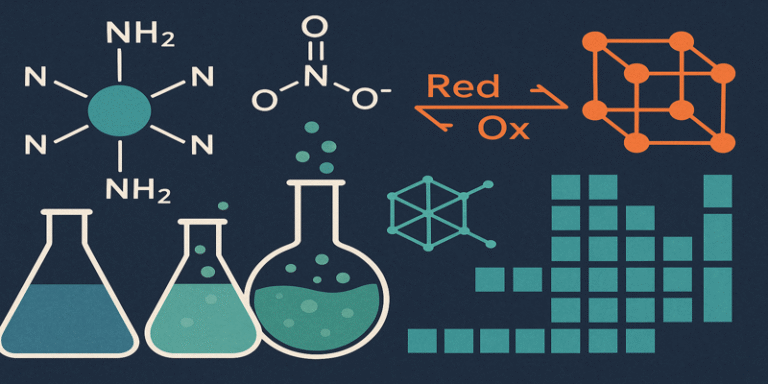In the expansive landscape of chemistry, inorganic chemistry holds a vital position, focusing on the study of substances not based on carbon-hydrogen (C–H) bonding. While organic chemistry dominates the understanding of life’s molecular foundation, inorganic chemistry governs much of the non-living world—metals, minerals, salts, oxides, and coordination complexes. From the batteries in our smartphones to the catalytic converters in our cars, the influence of inorganic chemistry is omnipresent.
What is Inorganic Chemistry?
Inorganic chemistry is the branch of chemical science concerned with the properties and behaviours of inorganic compounds—that is, compounds which are not primarily composed of carbon-hydrogen bonds. These include metals, ionic compounds, nonmetals, and organometallics, among others.
As Shriver and Atkins (2014) explain, inorganic chemistry covers a vast terrain: from the noble gases to the transition metals, and from simple salts to complex coordination compounds. One of its central aims is to understand how atoms interact to form compounds with specific chemical and physical properties.
This field introduces students to foundational topics such as:
- Atomic structure and periodicity
- Transition metal chemistry
- Crystal field theory
- Coordination chemistry
- Redox reactions
- Main group element chemistry
Understanding these principles provides insight into the periodic table’s logic and the behaviours of elements across different contexts.
The Periodic Table and Periodicity
The periodic table is the cornerstone of inorganic chemistry. It organises elements by increasing atomic number and recurring chemical properties. The concept of periodicity refers to patterns in element properties, such as ionisation energy, electronegativity, and atomic radius, which change predictably across periods and groups.
This pattern allows chemists to predict reactivity, bond formation, and compound properties. For example, alkali metals like sodium (Na) are highly reactive and form +1 cations, while noble gases like argon (Ar) are largely inert due to their full electron shells.
Transition Metal Chemistry
Transition metals—found in the centre of the periodic table—are a major focus of inorganic chemistry due to their unique ability to form multiple oxidation states, complexes, and coloured compounds. Their partially filled d-orbitals allow for variable bonding, making them essential for:
- Catalysis (e.g., platinum in catalytic converters)
- Biological systems (e.g., iron in haemoglobin)
- Industrial synthesis (e.g., nickel in hydrogenation reactions)
Understanding the chemistry of these elements enables the development of new materials, drugs, and technological devices (Housecroft & Sharpe, 2018).
Crystal Field and Ligand Field Theory
To explain the properties of coordination compounds, inorganic chemists use crystal field theory (CFT) and ligand field theory (LFT). These models describe how ligands—molecules or ions surrounding a central metal ion—affect the energy levels of d-orbitals in transition metal complexes.
CFT explains many observed features, including:
- Colour: Transitions between d-orbitals absorb visible light, giving rise to vivid colours.
- Magnetism: Depending on the splitting of orbitals and electron configuration, complexes may be paramagnetic or diamagnetic.
- Stability and geometry: Complexes can adopt octahedral, tetrahedral, or square planar geometries, influenced by the ligand field.
This theoretical framework is critical in bioinorganic chemistry, materials science, and coordination chemistry (Miessler et al., 2014).
Redox Chemistry and Electrochemical Applications
Another cornerstone of inorganic chemistry is redox (reduction-oxidation) chemistry, which deals with electron transfer reactions. These are central to many real-world systems, particularly in:
- Batteries: The movement of electrons between electrodes powers electronic devices.
- Corrosion: Uncontrolled redox reactions degrade materials like iron and steel.
- Electroplating and electrolysis: Redox processes deposit or extract elements using electrical energy.
Shriver and Atkins (2014) emphasise that understanding oxidation states and redox potentials is crucial for designing efficient electrochemical cells and energy storage systems.
Biological and Environmental Relevance
While traditionally viewed as a “non-living” science, inorganic chemistry is deeply embedded in biological systems. Many essential biomolecules contain metal ions:
- Haemoglobin uses iron to bind oxygen in red blood cells.
- Chlorophyll contains a magnesium ion at its centre, enabling photosynthesis.
- Zinc, copper, and manganese serve as cofactors for enzymatic activity.
This subfield, known as bioinorganic chemistry, explores how metal ions function in metabolic pathways, cell signalling, and enzyme catalysis (Bertini et al., 2007).
Similarly, environmental inorganic chemistry examines how elements like lead, arsenic, and mercury behave in soil and water systems, impacting ecosystems and human health.
Industrial and Technological Applications
The practical importance of inorganic chemistry cannot be overstated. It supports numerous sectors:
- Catalysis: Metal complexes are widely used in industrial synthesis. For example, the Haber-Bosch process uses an iron catalyst to synthesise ammonia, crucial for fertilisers.
- Nanotechnology: Inorganic materials, including quantum dots and metal-organic frameworks (MOFs), are revolutionising electronics, sensors, and drug delivery systems.
- Semiconductors: Elements like silicon, germanium, and gallium arsenide are fundamental in modern electronics.
- Construction and materials: Inorganic compounds such as cement, glass, and ceramics form the backbone of infrastructure.
According to Greenwood and Earnshaw (2012), inorganic chemistry enables the development of materials with tailored properties, from heat resistance to conductivity.
Modern Challenges and Research Frontiers
As we confront global challenges such as climate change, resource scarcity, and pollution, inorganic chemistry plays a key role in developing sustainable solutions:
- Solar energy conversion: Transition metal complexes are used in photovoltaic cells and artificial photosynthesis.
- Carbon capture and storage: Metal oxides and zeolites are investigated for their ability to absorb and sequester CO₂.
- Water purification: Metal-based catalysts and inorganic membranes can help remove contaminants from drinking water.
Cutting-edge research also includes inorganic nanomaterials, catalyst design, and metal-based drugs for cancer treatment (Mjos & Orvig, 2014).
Learning and Teaching Inorganic Chemistry
While some students may find inorganic chemistry less intuitive than organic chemistry due to its abstract bonding models and wide range of topics, modern teaching approaches focus on visual learning and contextual examples.
Practical laboratory work is crucial, allowing students to:
- Synthesise coordination compounds
- Perform qualitative analysis of metals
- Investigate redox reactions and crystal structures
Interactive models, 3D visualisation tools, and virtual labs are also being increasingly used to make the subject more accessible and engaging (RSC Education, 2022).
Inorganic chemistry may seem distant from everyday life at first glance, but it is in fact deeply embedded in the structure and function of the world around us. From the electrochemical cells that power our devices to the metal ions essential for life, the insights provided by inorganic chemistry are both fundamental and transformative.
This field empowers innovations in technology, medicine, energy, and materials science, making it a cornerstone of both scientific understanding and industrial progress. As research advances and new materials are engineered, inorganic chemistry continues to offer powerful tools for addressing the world’s most pressing challenges.
References
Bertini, I., Gray, H. B., Lippard, S. J. & Valentine, J. S. (2007). Bioinorganic Chemistry. University Science Books.
Greenwood, N. N. & Earnshaw, A. (2012). Chemistry of the Elements (2nd ed.). Butterworth-Heinemann.
Housecroft, C. E. & Sharpe, A. G. (2018). Inorganic Chemistry (5th ed.). Pearson.
Miessler, G. L., Fischer, P. J. & Tarr, D. A. (2014). Inorganic Chemistry (5th ed.). Pearson.
Mjos, K. D. & Orvig, C. (2014). “Metallo-Drugs: Development and Action of Metal-Based Therapeutics.” Chemical Reviews, 114(8), pp. 4540–4563.
RSC Education. (2022). Teaching and Learning Inorganic Chemistry: Strategies and Resources. Royal Society of Chemistry. Available at: https://edu.rsc.org
Shriver, D. F. & Atkins, P. W. (2014). Inorganic Chemistry (5th ed.). Oxford University Press.









